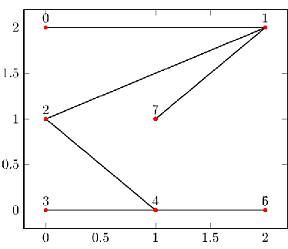|
Angelehnt an das Handbuch Öffne in Overleaf
Nr. x y \\ 0 0 2 \\%0 1 2 2 \\%1 2 0 1 \\%2 3 0 0 \\%3 ... in der ich in einem umfunktionierten Öffne in Overleaf
patch table with point meta={% Startpkt Endpkt colordata \\%colordata weglassen, dann vermutl. autom. 0 1 2 \\% 1 0 \\ 1 7 \\ 2 4 \\ .... 7 7 \\ % Kein Strich } Frage: Warum muss ich hierbei, wie im Handbuch die Beschriftungen durch einen Extraplot ergänzen und kann dies nicht im 1. eigentlichen Plot machen? Öffne in Overleaf
% replicate the vertex list to show \coordindex: \addplot[only marks, nodes near coords=\coordindex, ] table[row sep=\\] { 0 2 \\%0 2 2 \\%1 ..... 1 1 \\%7 }; Wenig Hoffnung auf eine AW, wenn das bereits im Handbuch so gemacht wird, aber vll. hat ja jmd. eine Idee. Vollständiges MWE: Öffne in Overleaf
\documentclass[margin=5mm, tikz]{standalone} \usepackage{pgfplots} \usepgfplotslibrary{patchplots} \begin{document} \begin{tikzpicture} \begin{axis}[ colormap={Kantenfarbe}{color=(gray) color=(gray)}, ] \addplot+[ % Punkte mark size=1.125pt, mark options={red}, % Kanten thick, % Beschriftung % visualization depends on={{aaa} \as \test}, %nodes near coords=\coordindex, % TUT -hier- NICHT ?! table/row sep=\\, % Muss wohl so sein!? patch, % Plot-Typ patch type=polygon, vertex count=2, % damit nur Kanten, keine Flächen, gezeichnet werden patch table with point meta={% Startpkt Endpkt colordata \\%colordata weglassen, dann vermutl. autom. 0 1 2 \\% 1 0 \\ 1 7 \\ 2 4 \\ 3 4 \\ 4 6 \\ 5 4 \\ 6 4 \\ 7 7 \\ % Kein Strich } ] table[header=true, x index=1, y index=2] { Nr. x y \\ 0 0 2 \\%0 1 2 2 \\%1 2 0 1 \\%2 3 0 0 \\%3 4 1 0 \\%4 5 2 0 \\%5 6 2 0 \\%6 7 1 1 \\%7 }; % replicate the vertex list to show \coordindex: \addplot[only marks, nodes near coords=\coordindex, every node near coord/.append style={ %text=blue }, ] table[header=true, x index=1, y index=2] { Nr. x y \\ 0 0 2 \\%0 1 2 2 \\%1 2 0 1 \\%2 3 0 0 \\%3 4 1 0 \\%4 5 2 0 \\%5 6 2 0 \\%6 7 1 1 \\%7 }; \end{axis} \end{tikzpicture} \end{document} |
Folgen dieser Frage
Per E-Mail:Wenn sie sich anmelden, kommen Sie für alle Updates hier in Frage
Per RSS:Markdown-Grundlagen
- *kursiv* oder _kursiv_
- **Fett** oder __Fett__
- Link:[Text](http://url.com/ "Titel")
- Bild?
- nummerierte Liste: 1. Foo 2. Bar
- zum Hinzufügen ein Zeilenumbruchs fügen Sie einfach zwei Leerzeichen an die Stelle an der die neue Linie sein soll.
- grundlegende HTML-Tags werden ebenfalls unterstützt
Frage-Themen:
gestellte Frage: 28 Aug '18, 17:16
Frage wurde gesehen: 3,092 Mal
zuletzt geändert: 17 Sep '18, 01:05


Sehe ich das richtig, dass die letzte Tabelle nur eine truncation der zweiten ist, d.h. Du könntest die zweite recyclen?
Ja, das ist einfach nochmal die Wiederholung der Koordinaten.
Man müsste irgendwas mit ifthenelse programmieren. Wenn die node near coords schon gesetzt wurde nicht nochmal gesetzt wird. Mal schauen, ob ich das hinkriege.
Theoretisch irgendwie sowas, tut nur leider nicht.
nodes near coords={% \foreach \t in {1,2,3,...,10}{%%% natürliche Zahlenfolge \pgfmathsetmacro{\u}{0}% \foreach \x in {\punktnummer}{% zu testende Zahlen \ifx \x\t% \global\let\u=\t% \fi% }% \ifx \u\t% {\t}% \else{}% Leer \fi% }%%% }Sowas kannst Du im Prinzip schon machen, nur dass Du die
nodes near coordsmeines Wissens nicht mit einem code füttern kannst, zumindest nicht auf diese Weise. Du kannst Dir einen Code definieren mit\pgfplotsset{cis Magie/.code={...}}, wo Du sowas wie oben eintragen kannst (nur dass ich\ifnumverwenden würde), und dannevery node near coord/.append style={ /pgfplots/cis Magie },sagen. Und jetzt musst Du natürlich das Ergebnis des codes an dienodes near coordskommunizieren, anstatt Leer kannst Du evtl.\pgfkeysalso{opacity=0}nehmen...